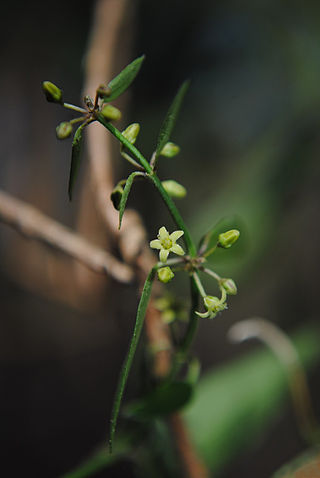
The monarch butterfly or simply monarch is a milkweed butterfly in the family Nymphalidae. Other common names, depending on region, include milkweed, common tiger, wanderer, and black-veined brown. It is among the most familiar of North American butterflies and an iconic pollinator, although it is not an especially effective pollinator of milkweeds. Its wings feature an easily recognizable black, orange, and white pattern, with a wingspan of 8.9–10.2 cm (3.5–4.0 in). A Müllerian mimic, the viceroy butterfly, is similar in color and pattern, but is markedly smaller and has an extra black stripe across each hindwing.

The Asclepiadoideae are a subfamily of plants in the family Apocynaceae. Formerly, they were treated as a separate family under the name Asclepiadaceae, e.g. by APG II, and known as the milkweed family.

Coreopsis is a genus of flowering plants in the family Asteraceae. Common names include calliopsis and tickseed, a name shared with various other plants.

Stapeliinae is a subtribe of flowering plants within the tribe Ceropegieae of the subfamily Asclepiadoideae of the family Apocynaceae. The subtribe comprises about 35 genera, including both the stem-succulent "stapeliads" and the horticulturally popular genera Brachystelma and Ceropegia. The largest number of genera are native to Africa, but a more limited number of genera are widespread in Arabia and Asia. Historically, a similarly circumscribed taxon was treated as a separate tribe, Stapelieae.

Cynanchum is a genus of about 300 species including some swallowworts, belonging to the family Apocynaceae. The taxon name comes from Greek kynos and anchein, hence the common name for several species is dog-strangling vine. Most species are non-succulent climbers or twiners. There is some evidence of toxicity.

Ageratina altissima, also known as white snakeroot, richweed, or white sanicle, is a poisonous perennial herb in the family Asteraceae, native to eastern and central North America. An older binomial name for this species is Eupatorium rugosum, but the genus Eupatorium has undergone taxonomic revision by botanists, and some species once included in it have been moved to other genera.

Stephanotis is a genus of flowering plants first described in 1806. The name derives from the Greek stephanōtís fit for a crown, derivative of stéphanos (masculine) crown. It contains evergreen, woody-stemmed lianas with a scattered distribution in several tropical and subtropical regions.

Araujia sericifera is a perennial vining plant in the genus Araujia, of the family Apocynaceae, that is native to South America. The species was described in 1817 by the Portuguese botanist Félix de Avelar Brotero. The synonym Araujia hortorum is in more frequent use in New Zealand. Its common names include bladderflower, white bladderflower, bladder vine, cruel vine, cruel plant, moth plant, moth vine, common moth vine, and false choko.

Vincetoxicum is a genus of plants in the family Apocynaceae. Although the species in Vincetoxicum have sometimes been included in Cynanchum, chemical and molecular evidence shows that Vincetoxicum is more closely related to Tylophora, now included in Vincetoxicum. The generic name means "poison-beater" in Botanical Latin because of the plants' supposed antidotal effects against snakebite.

Lonicera sempervirens is a flowering plant species of honeysuckle vine native to the eastern United States which is known for its reddish flowers.

Pycnanthemum is a genus of herbaceous plants in the mint family (Lamiaceae). Species in this genus are often referred to as "mountain mints" and they often have a minty or thyme-like aroma when crushed. All species of Pycnanthemum are native to the United States and Canada. The center of diversity for the genus is North Carolina with 13 of the 20 species having been collected therein. Nineteen of the 20 species of Pycnanthemum occur in the Eastern US and Canada, and one disjunct species occurs in California and Oregon.

Chiococca alba is a species of flowering plant in the coffee family (Rubiaceae) native to Florida and the extreme southern tip of Texas in the United States, Bermuda, Mexico, Central America, the Caribbean, the Galápagos, and tropical South America. Common names include David's milkberry, West Indian milkberry, cahinca and West Indian snowberry. The specific epithet, alba, means "white" in Latin and refers to the color of its fruits.

Cynanchum viminale is a leafless succulent plant in the family Apocynaceae. The species is native to West Africa, the Indian Ocean and Western Pacific region. The species' natural range extends from South Africa throughout much of Africa and the Middle East to India, Indochina, Southern China, Indomalaya and into Meganesia. The species is also found on several Indian Oceans islands including Mauritius, Réunion and the Seychelles.

Funastrum is a genus of flowering plant now in the family Apocynaceae. The name is derived from the Latin word funis, meaning "rope", and astrum, alluding to the twining stems. Members of the genus are commonly known as twinevines.
Arisaema quinatum is a species of flowering plant in the arum family Araceae. It is a member of the Arisaema triphyllum complex, a group of closely related taxa in eastern North America. The specific name quinatum means "divided into five lobes", a reference to its characteristic leaves. It is commonly known as the southern Jack-in-the-pulpit but some refer to it as Preacher John.
Dischidanthus is a genus of plants in the family Apocynaceae, first described as a genus in 1936. Species of the genus are native from the east Himalayas to south China and Peninsular Malaysia. It may be treated by some sources as a synonym of Marsdenia.

Orthosia is a genus of plants in the family Apocynaceae, first described as a genus in 1844.
Leichhardtia mackeeorum, synonym Marsdenia mackeeorum, is a species of vine in the family Apocynaceae. It is endemic to New Caledonia.

Rosa setigera, commonly known as the climbing rose, prairie rose, and climbing wild rose, is a species of shrub or vine in the Rosaceae (rose) family native to central and eastern North America.
Vincetoxicum forsteri is a species of plant in the dogbane family Apocynaceaethat is endemic to Australia. It was first described by Paul Irwin Forster in 1992 as Tylophora linearis.


















